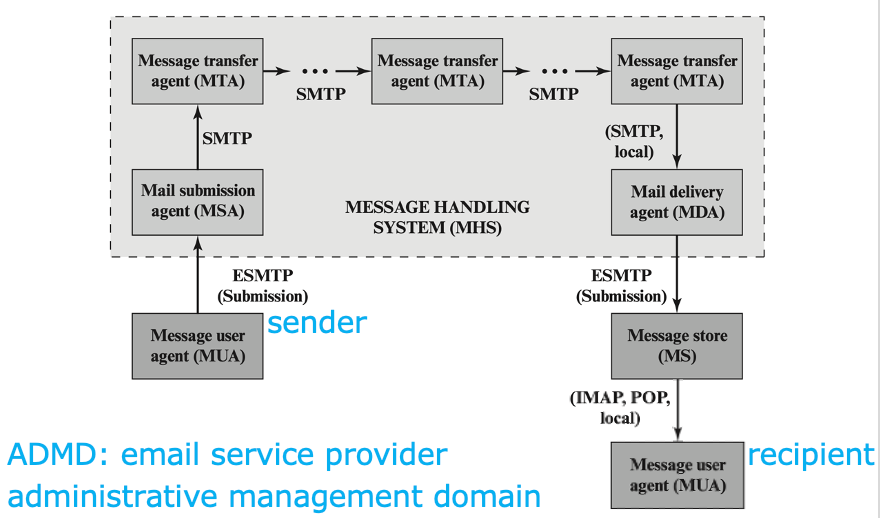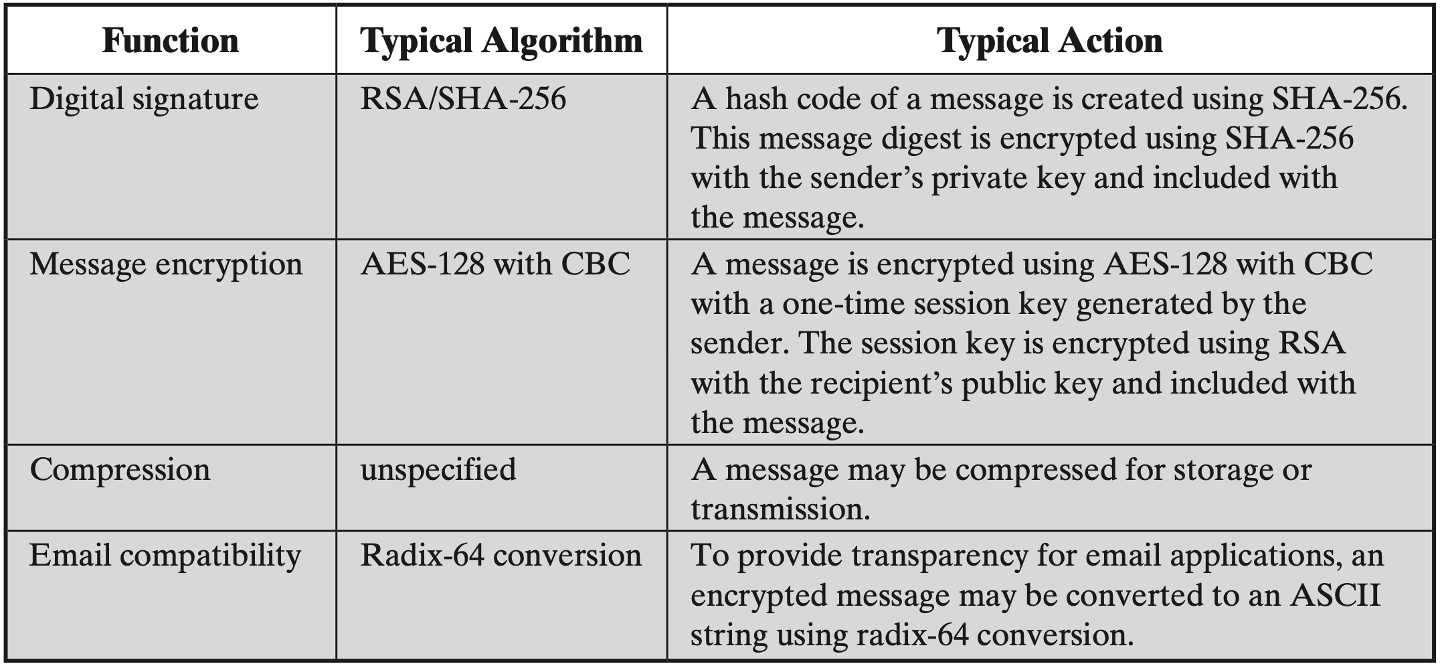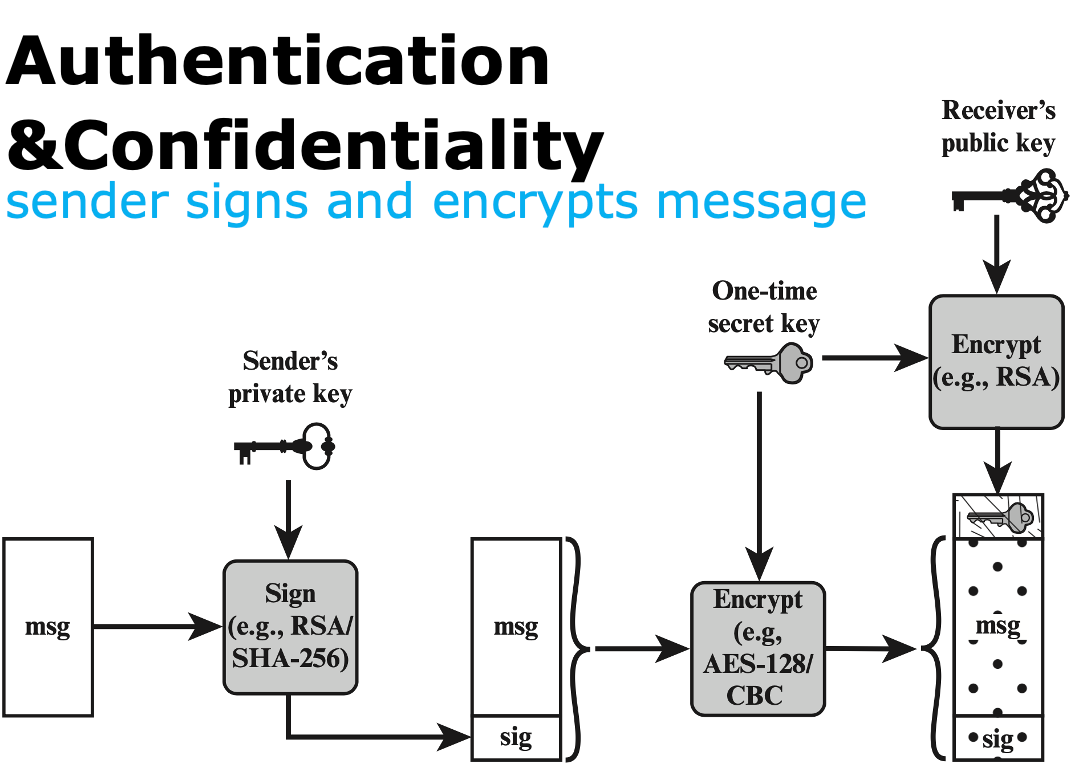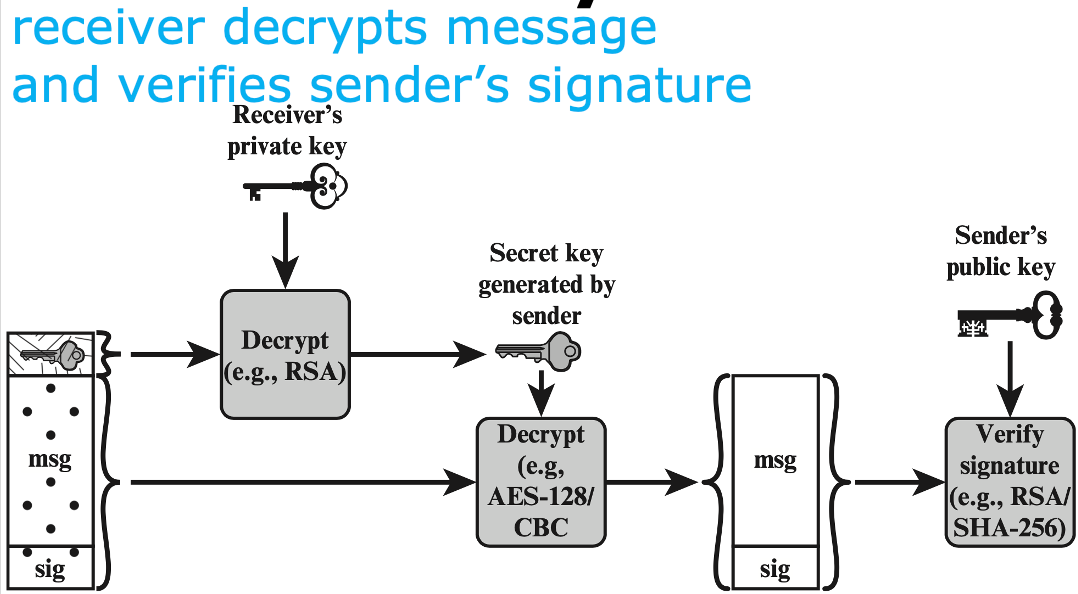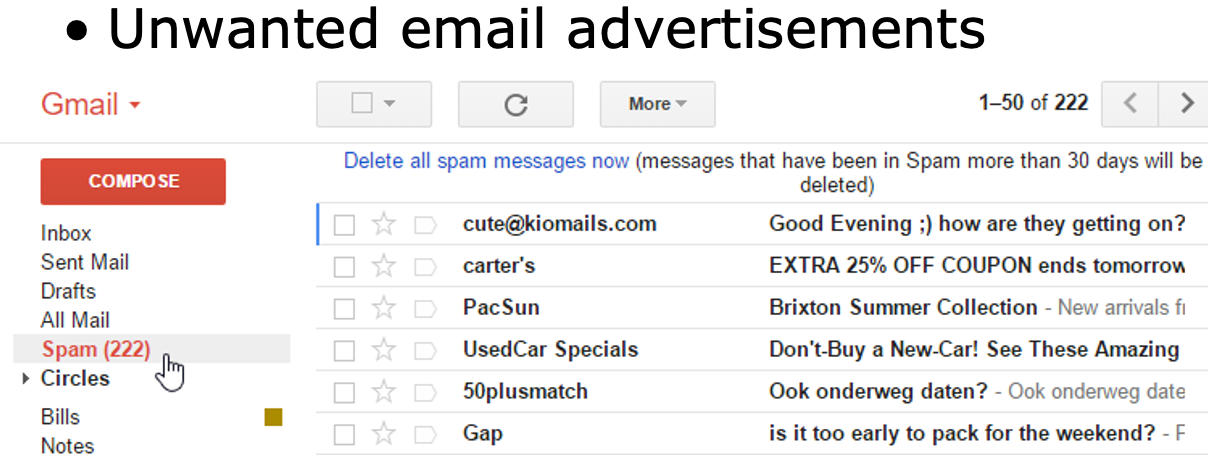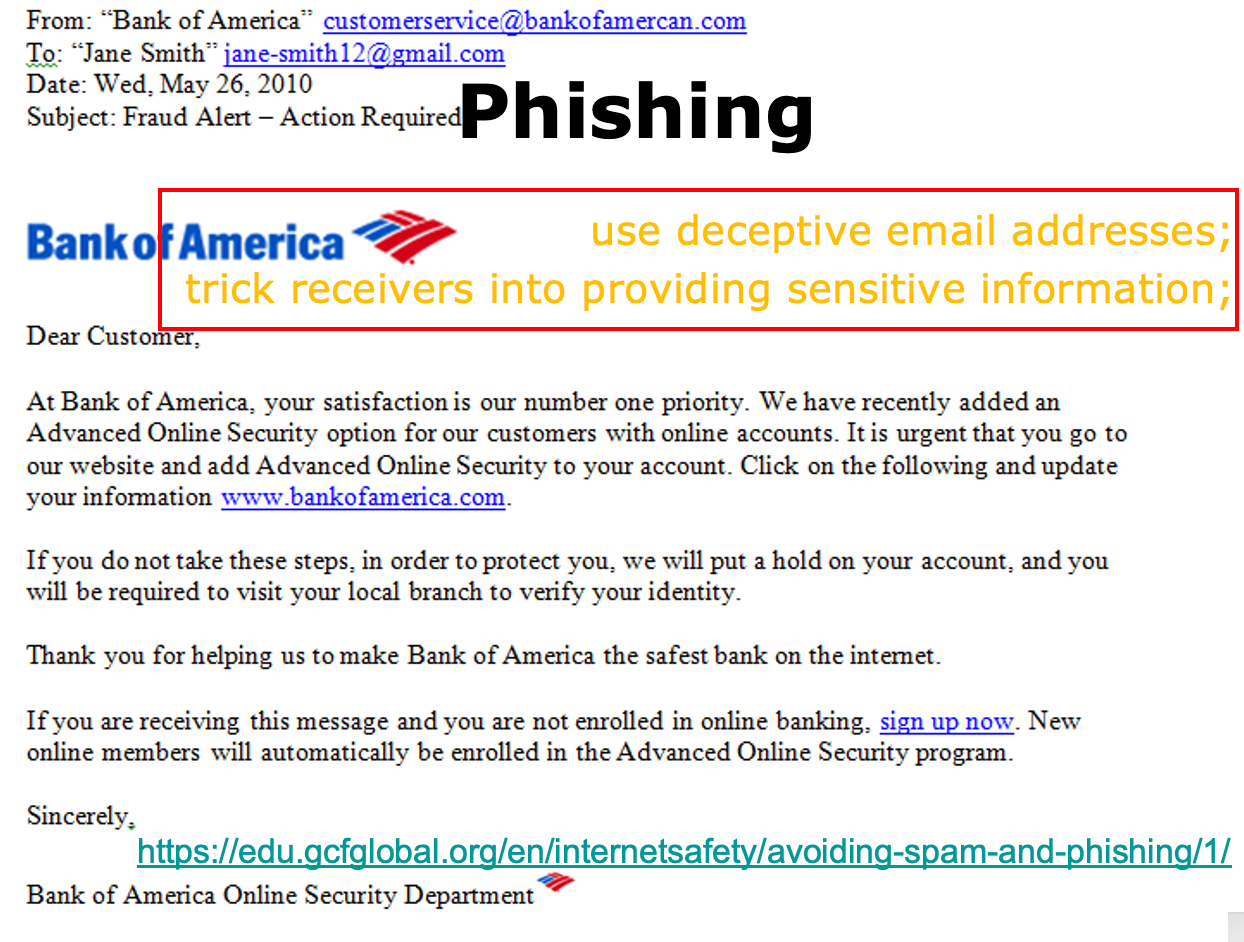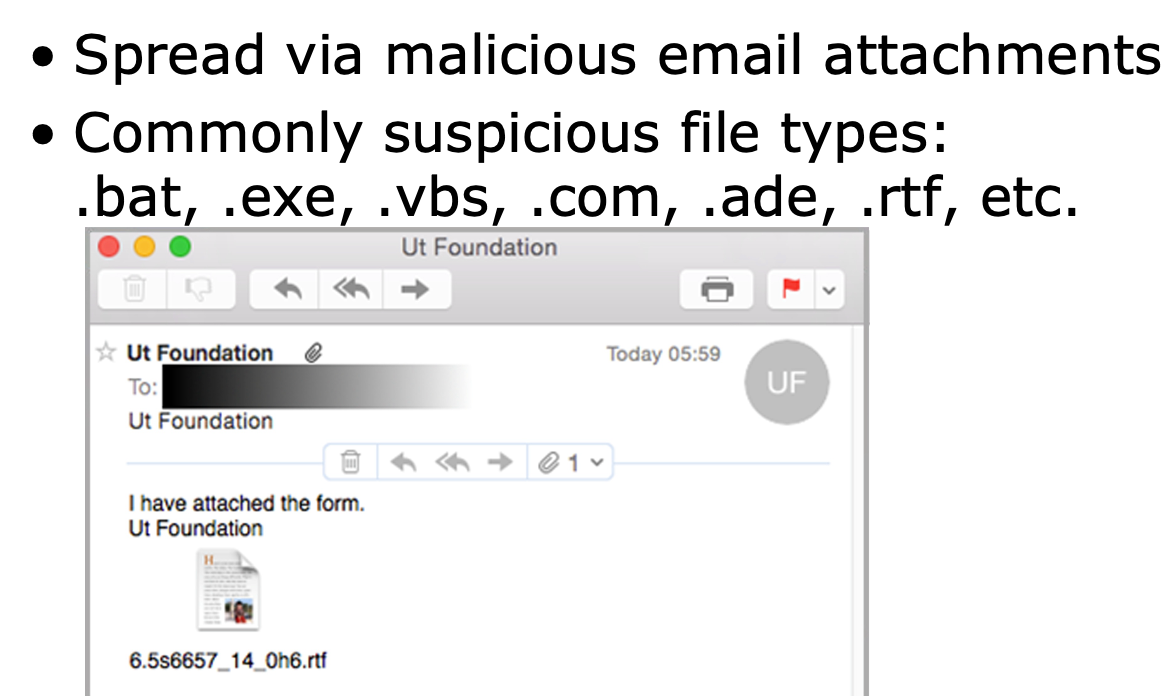Email Security👀
约 1401 个字 预计阅读时间 5 分钟
Email Architecture👀
MUA (Message User Agent)
- hosted on a client email program or a local network email server;
- sender MUA formats a message and performs initial submission into MHS via an MSA (Mail Submission Agent);
- recipient MUA processes received email for storage and/or display to the recipient user
MHS (Message Handling Service)
- composed of MTAs (Message Transfer Agents);
- accepts a message from sender and delivers it to one or more recipients;
- creates a virtual MUA-to-MUA environment;
Email Protocol:
- Type 1: SMTP (Simple Mail Transfer Protocol)
- move messages through the Internet from source to destination;
- Type 2: IMAP (Internet Message Access Protocol) and POP (Post Office Protocol)
- transfer messages between mail servers
POP3 downloads the email from a server to a single computer, then deletes the email from the server. IMAP stores the message on a server and synchronizes the message across multiple devices
Email Format
- RFC 5322
- view messages as having an envelope and contents;
- envelope contains whatever information needed to accomplish transmission and delivery;
- contents compose the object to be delivered to the recipient;
- RFC 5322 applies only to the contents;
- the content standard includes a set of header fields that may be used by the mail system to create the envelope;

- view messages as having an envelope and contents;
- MIME (Multipurpose Internet Mail Extensions)
- extend RFC 5322 with enhancements;
- Define five new header fields to provide information about message content
- Standardize representations that support multimedia electronic mail
- Define transfer encodings that enable the conversion of any content format into a form that is protected from alteration by the mail system
MIME Header
- MIME-Version
- Content-Type
- Content-Transfer-Encoding
- Cotent-ID
- Content-Description
Email Security Threats👀
- Authentication-related Threats
- could result in unauthorized access to an email system
- Integrity-related Threats
- could result in unauthorized modification of email content
- Confidential-related Threats
- could result in unauthorized disclosure of sensitive information
- Availability-related Threats
- could prevent end users from being able to send or receive email
S/MIME👀
Secure / Multipurpose Internet Mail Extension
- Authentication | 认证
- Confidentiality | 保密
- Compression | 压缩
- Email compatibility | 兼容
Authentication👀
- the sender creates a message
- use SHA-256 to generate a 256-bit message digest
- encrypt the message digest with RSA using the sender’s private key; append the result as well as the signer’s identity to the message
- the receiver uses RSA with the sender’s public key to decrypt, recover, and verify the message digest
Confidentiality👀
- the sender creates a message and a random 128-bit number as a content-encryption key for this message only
- encrypt the message using the content-encryption key
- encrypt the content-encryption key with RSA using the receiver’s public key and append it to the message
- The receiver uses RSA with its private key to decrypt and recover the content-encryption key
- use the content-encryption key to decrypt the message
Authentication&Confidentiality
All processes on the sender: including the process that the sender uses RSA and receiver’s public key to encrypt one-time secret key and append it to the encrypted message;
Content Type👀
- Data:
- inner MIME-encoded message content; may be encapsulated in the following types;
- SignedData:
- digital signature of a mesasge
- EnvelopedData
- encrypted data of any type, and encrypted content-encryption keys for one or more recipients;
- CompressedData
- data compression of a message
PGP👀
Pretty Good Privacy, same functionality as S/MIME,free and popular for personal use.
与 S/MIME 不同的是:
- Key Certification
- S/MIME uses X.509 certificates issued by CA or delegated authorities; | S/MIME 使用由 CA 或授权机构颁发的 X.509 证书
- OpenPGP allows users to generate their own OpenPGP public and private keys, and then solicit signatures for their public keys from known individuals or organizations
- Key Distribution
- OpenPGP does not include the sender’s public key with each message;
- recipient needs to separately obtain that from TLS-protected websites or OpenPGP public key servers;
- no vetting of OpenPGP keys, users decide whether to trust on their own
NIST 800-177 recommends the use of S/MIME rather than PGP because of the greater confidence in the CA system of verifying public keys
DANE👀
If any of the hundreds of CAs operating on the Internet is compromised, the effects can be widespread.
The attacker can obtain the CA’s private key, get issued certificates under a false name, or introduce new bogus root certificates into a root certificate store.
- DNS-based Authentication of Named Entities
- allow X.509 certificates to be bound to DNS names using DNSSEC
- The purpose of DANE is to replace reliance on the security of the CA system with reliance on the security provided by DNSSEC.
- Given that the DNS administrator for a domain name is authorized to give identifying information about the zone, it makes sense to allow that administrator to also make an authoritative binding between the domain name and a certificate that might be used by a host at that domain name.
TLSA Record👀
- TLS Authentication Record
- A new DNS record type defined by DANE
- Used for a secure method of authenticating SSL/TLS certificates
- Specify constraints on which CA can vouch for a certificate, or which specific PKIX [Public Key Infrastructure (X.509)] end-entity certificate is valid. | 指定 CA 可以为证书提供担保的约束条件,或指定特定的 PKIX [Public Key Infrastructure (X.509)] end-entity 证书有效的约束条件。
- Specify that a service certificate or a CA can be directly authenticated in the DNS itself. | 指定可以直接在 DNS 中认证的 service certificate 或者 CA。
Format
- format of TLSA as it is transmitted to a requesting entity
- Certificate Usage:
- define four different usage models, to accommodate users who require different forms of authentication
- PKIX-TA (CA constraint): Specifies which CA should be trusted to authenticate the certificate for the service
- PKIX-EE (service certificate constraint): Defines which specific end entity service certificate should be trusted for the service
- DANE-TA (trust anchor assertion): Specifies a domain-operated CA to be used as a trust anchor
- DANE-EE (domain-issued certificate): Specifies a domain-operated CA to be used as a trust anchor
- Selector
- indicate whether the full certificate will be matched or just the value of the public key
- Matching Type
- indicate how the match of the certificate is made: exact match, SHA-256 hash match, or SHA-512 hash match
- Certificate Association Data
- represent the raw certificate data in hex format
DANE For SMTP👀
DANE (DNS-based Authentication of Named Entities)
- Targeted vulnerabilities:
- attackers can strip away the TLS capability advertisement and downgrade the connection to not use TLS;
- TLS connections are often unauthenticated (e.g., the use of self-signed certificates as well as mismatched certificates is common)
- A domain can use the presence of TLSA as an indicator that encryption must be performed, thus preventing malicious downgrade
- A domain can authenticate the certificate used in the TLS connection setup using a DNSSEC-signed TLSA
DANE For S/MIME👀
- Introduce a SMIMEA DNS record to associate certificates with DNS domain names
- Help MUAs to deal with domain names as specified in email addresses in the message body (rather than domain names specified in the outer SMTP envelope – purpose of TLSA)
SPF👀
SPF (Sender Policy Framework)
- ADMDs (Administrative Management Domains) publish SPF records in DNS specifying which hosts/IP-addresses are permitted to use their names;
- receivers use the published SPF records to test the authorization of sending Mail Transfer Agents (MTAs) using a given “HELO” or “MAIL FROM” identity during a mail transaction;
An SMTP client, after receiving the greeting message, will normally send an HELO or EHLO command: where the domain given is the fully qualified name (host+domain) of the sending client.
DKIM👀
- sign email message by a private key of the administrative domain from which the email originates;
- at the receiving end, the MDA can access the corresponding public key via a DNS and verify the signature, thus authenticating that the message comes from the claimed administrative domain
MDA (Mail Delivery Agent)
- SPF lets receiving servers know the sending sources permitted to send email messages on your domain’s behalf.
- DKIM tells receiving servers that incoming messages purporting to come from your domain/organization must have a digital signature that matches the public key in your DKIM record.
- Difference from S/MIME and PGP:
- S/MIME and PGP use the sender’s private key to sign the content of the message;
- DKIM uses the private key of the domain where the sender locates;
